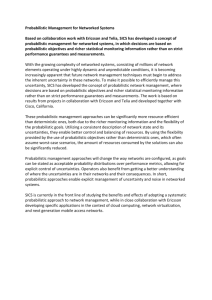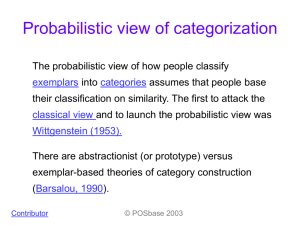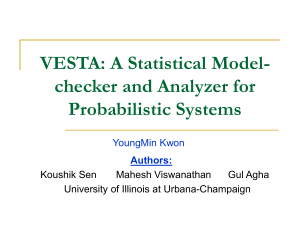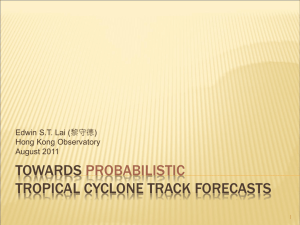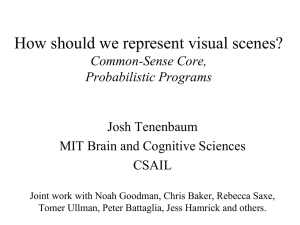new features 5.7
advertisement
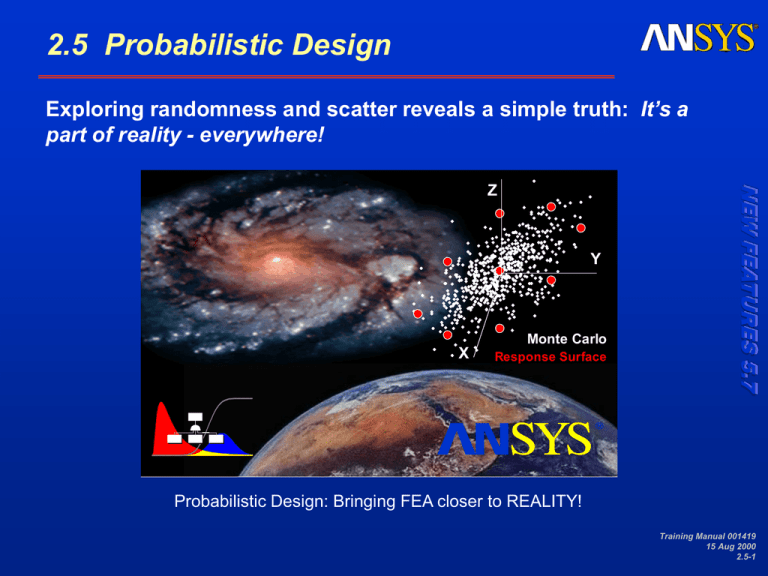
2.5 Probabilistic Design Exploring randomness and scatter reveals a simple truth: It’s a part of reality - everywhere! Y Monte Carlo X Response Surface NEW FEATURES 5.7 Z Probabilistic Design: Bringing FEA closer to REALITY! Training Manual 001419 15 Aug 2000 2.5-1 Probabilistic Design Introduction – Recognises the fact that input parameters do vary despite the best intentions. – Predicts variation in design performance. – Allows design for reliability. NEW FEATURES 5.7 • Probabilistic Design takes into account uncertainties (scatter) in input data and performs multiple runs to calculate scatter in output data. Training Manual 001419 15 Aug 2000 2.5-2 Probabilistic Design … Introduction • • • ANSYS Output • • • Material properties Geometry Boundary Conditions It’s a reality that input parameters are subjected to scatter => automatically the output parameters are uncertain as well!! Deformation Stresses, strains Fatigue, creep,... NEW FEATURES 5.7 Input Training Manual 001419 15 Aug 2000 2.5-3 Probabilistic Design … Introduction • Typical questions answered with probabilistic design: – What is the probability that output parameters do not fulfil design criteria (failure probability)? – How much does the scatter of the input parameters contribute to the scatter of the output (sensitivities)? NEW FEATURES 5.7 – How large is the scatter of the output parameters? ANSYS PDS Training Manual 001419 15 Aug 2000 2.5-4 Probabilistic Design … Introduction • The goal is to design more reliable products by estimating a component's lifetime. Material • Strength • Material Properties Loads • Thermal • Structural Finite-Element Model Random Output Parameters • LCF lifetime • Creep lifetime • Corrosion lifetime • Fracture mechanical lifetime •… NEW FEATURES 5.7 Random Input Variables Geometry/ Tolerances BC's • Gaps • Fixation Training Manual 001419 15 Aug 2000 2.5-5 Probabilistic Design … Introduction • Probabilistic Design System (PDS) is useful in several industries and applications, e.g: – Gas Turbines (Rotating Machinery) – Automotive (Power Train) NEW FEATURES 5.7 – Aerospace Training Manual 001419 15 Aug 2000 2.5-6 Probabilistic Design … Introduction Deterministic Analysis Probabilistic Analysis Only provides a YES/NO answer. • Provides a probability and reliability (design for reliability). • Safety margins are piled up “blindly” (worst material, maximum load, … worst case). Leads to costly over-design. • Takes uncertainties into account in a realistic fashion. • Only “as planned,” “as is,” or the worst design. • “Tolerance stack-up” taken into account • Sensitivities do not take interactions between input variables into account (second order cross terms). • Range/width of scatter is “builtin” into probabilistic sensitivities. • Inherently takes into account interactions between input variables. – Closer to reality – Over-design is avoided NEW FEATURES 5.7 • Training Manual 001419 15 Aug 2000 2.5-7 Probabilistic Design PDS Features • Works with any ANSYS model. • Allows large number random input and output parameters (max. total = input plus output is 5000). • Ten statistical distributions for input parameters. • Random input parameters can be correlated. • Probabilistic methods: NEW FEATURES 5.7 – Static, dynamic, linear, non-linear, thermal, Structural, Electro-magnetic, CFD … – Monte Carlo - Direct & Latin Hypercube Sampling – Response Surface - Central Composite & Box-Behnken Designs Training Manual 001419 15 Aug 2000 2.5-8 Probabilistic Design … PDS Features • Comprehensive probabilistic results, e.g: – Convergence plots – Probabilities – Scatter plots – Sensitivities • State-of-the art statistical procedures to analyze and visualize probabilistic results NEW FEATURES 5.7 – Histogram • Use of distributed, parallel computing techniques for drastically reduced wall clock time of the analysis Training Manual 001419 15 Aug 2000 2.5-9 Probabilistic Design GUI for PDS – Start by creating a loop file of any analysis – Define the problem – Specify methods and run options – Fit response surfaces – Postprocessing NEW FEATURES 5.7 • PDS menus are organized according to sequence of use, similar to design optimization menu: – Database handling Training Manual 001419 15 Aug 2000 2.5-10 Probabilistic Design PDS Results • Different types of results displays are available to answer typical PDS questions: • These plots can be used to answer the question "How large is the scatter of the output parameters?" – Cumulative distribution function, probabilities • "What is the probability that output parameters do not fulfil design criteria (failure probability)?" – Sensitivities, scatter diagram, response surface • "How much does the scatter of the input parameters contribute to the scatter of the output?" NEW FEATURES 5.7 – Statistics, histogram, sample diagrams Training Manual 001419 15 Aug 2000 2.5-11 Probabilistic Design Probabilistic Results Simulation Value Sample Plot: NEW FEATURES 5.7 Training Manual 001419 15 Aug 2000 2.5-12 Probabilistic Design Probabilistic Results Mean Value Sample Plot NEW FEATURES 5.7 Training Manual 001419 15 Aug 2000 2.5-13 Probabilistic Design Probabilistic Results Standard Deviation Sample Plot: NEW FEATURES 5.7 Training Manual 001419 15 Aug 2000 2.5-14 Probabilistic Design Probabilistic Results Histogram Plot: NEW FEATURES 5.7 For random input variables For random output parameters Training Manual 001419 15 Aug 2000 2.5-15 Probabilistic Design Probabilistic Results Cumulative Distribution Function: NEW FEATURES 5.7 Training Manual 001419 15 Aug 2000 2.5-16 Probabilistic Design Probabilistic Results Sensitivities: NEW FEATURES 5.7 Note: Sensitivity plot for • Spearman rank order correlation coefficient • Linear correlation coefficient • Single parameter Sensitivity study Training Manual 001419 15 Aug 2000 2.5-17 Probabilistic Design Probabilistic Results Scatter Plot: NEW FEATURES 5.7 Training Manual 001419 15 Aug 2000 2.5-18 Probabilistic Design Summary • Probabilistic Design is a new feature at ANSYS 5.7 • Based on widely accepted Monte Carlo simulation technique and Response Surface methods • Allows for parallel / distributed processing of jobs NEW FEATURES 5.7 • An easy-to-use tool for realistic prediction of reliability Training Manual 001419 15 Aug 2000 2.5-19
